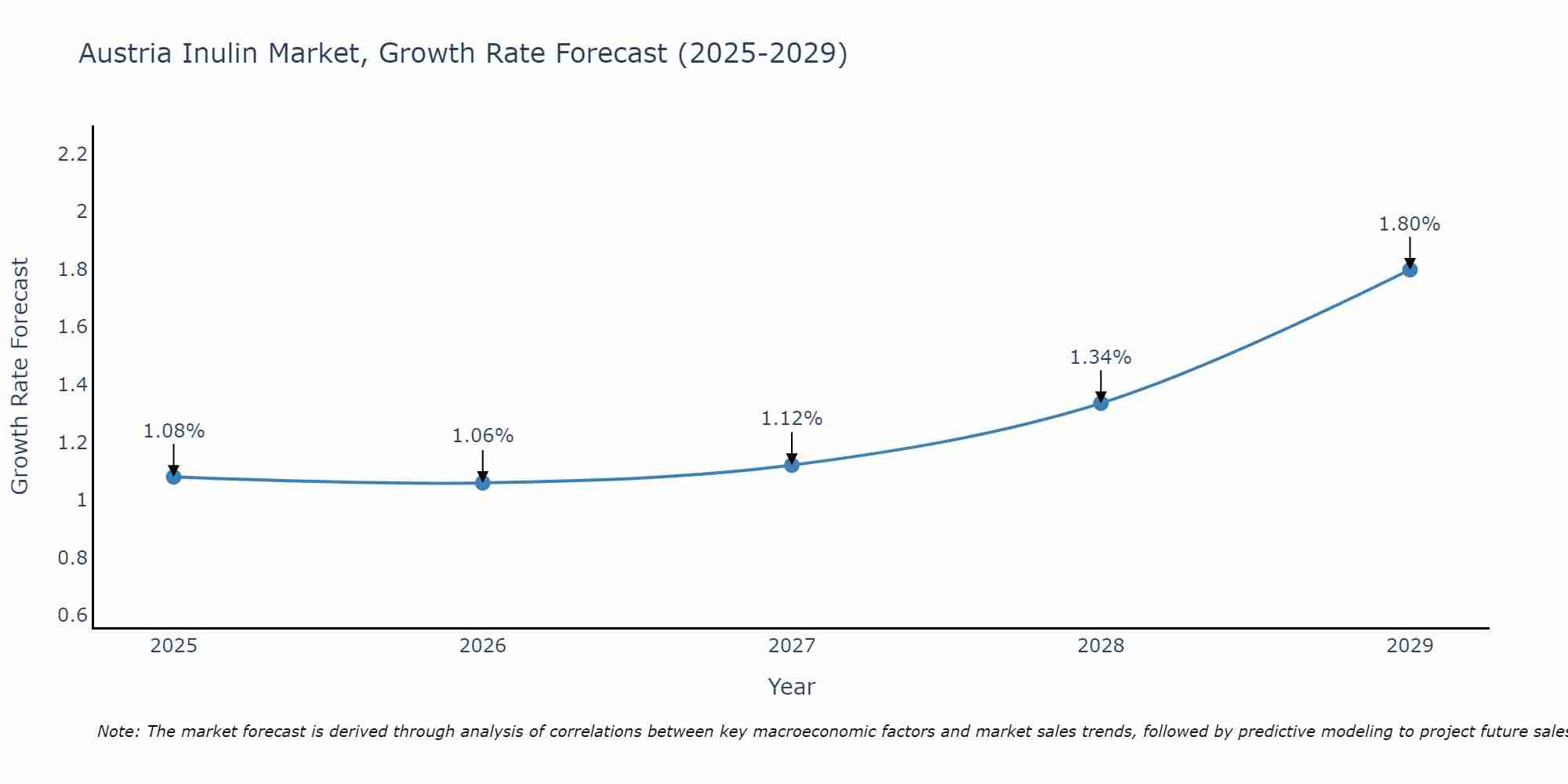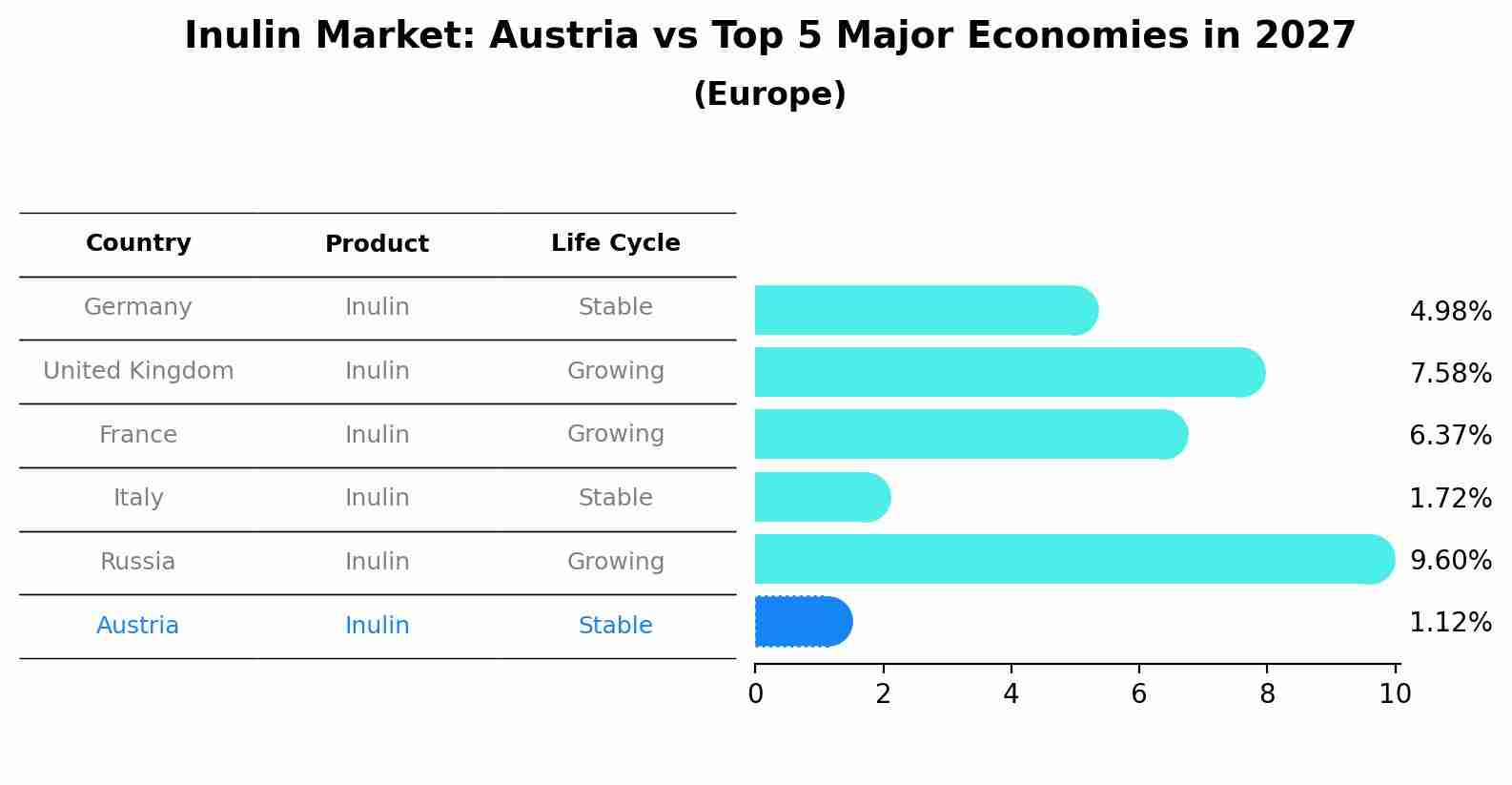Austria Inulin Market (2025-2031) | Segmentation, Forecast, Share, Trends, Outlook, Revenue, Analysis, Industry, Companies, Size, Value & Growth
| Product Code: ETC4846386 | Publication Date: Nov 2023 | Updated Date: Sep 2025 | Product Type: Market Research Report | |
| Publisher: 6Wresearch | No. of Pages: 60 | No. of Figures: 30 | No. of Tables: 5 | |
Austria Inulin Market Size Growth Rate
The Austria Inulin Market is projected to witness mixed growth rate patterns during 2025 to 2029. The growth rate starts at 1.08% in 2025 and reaches 1.80% by 2029.

Inulin Market: Austria vs Top 5 Major Economies in 2027 (Europe)
By 2027, the Inulin market in Austria is anticipated to reach a growth rate of 1.12%, as part of an increasingly competitive Europe region, where Germany remains at the forefront, supported by United Kingdom, France, Italy and Russia, driving innovations and market adoption across sectors.

Austria Inulin Market Overview
Austria`s inulin market is expanding as consumers seek natural and health-promoting ingredients. Inulin, a dietary fiber, is used in food and beverage products for its prebiotic properties, promoting digestive health and aiding in weight management.
Drivers of the market
The inulin market is experiencing growth due to the rising demand for dietary fibers and prebiotic ingredients in functional foods. As consumers become more health-conscious and seek products that support digestive health, inulin is gaining popularity for its benefits in gut health and weight management. Additionally, the trend towards clean-label products and natural ingredients is encouraging manufacturers to incorporate inulin into a variety of food and beverage products, driving market expansion.
Challenges of the market
In the inulin market, manufacturers face challenges related to fluctuating consumer preferences and demand for natural ingredients. The need for transparency in sourcing and production processes is critical for maintaining market share. Additionally, competition from alternative dietary fibers necessitates ongoing innovation and effective marketing strategies.
Government Policy of the market
The inulin market in Austria is supported by government initiatives focused on promoting healthy dietary choices and nutrition. The government emphasizes the importance of dietary fibers in public health campaigns, highlighting the benefits of inulin as a prebiotic fiber that supports digestive health. Regulatory frameworks govern labeling and health claims for food products containing inulin, ensuring transparency and consumer protection. The government encourages research into the health benefits of inulin, fostering innovation in food product development that incorporates this functional ingredient.
Key Highlights of the Report:
- Austria Inulin Market Outlook
- Market Size of Austria Inulin Market, 2024
- Forecast of Austria Inulin Market, 2031
- Historical Data and Forecast of Austria Inulin Revenues & Volume for the Period 2021-2031
- Austria Inulin Market Trend Evolution
- Austria Inulin Market Drivers and Challenges
- Austria Inulin Price Trends
- Austria Inulin Porter`s Five Forces
- Austria Inulin Industry Life Cycle
- Historical Data and Forecast of Austria Inulin Market Revenues & Volume By Form for the Period 2021-2031
- Historical Data and Forecast of Austria Inulin Market Revenues & Volume By Powder for the Period 2021-2031
- Historical Data and Forecast of Austria Inulin Market Revenues & Volume By Liquid for the Period 2021-2031
- Historical Data and Forecast of Austria Inulin Market Revenues & Volume By Nature for the Period 2021-2031
- Historical Data and Forecast of Austria Inulin Market Revenues & Volume By Organic for the Period 2021-2031
- Historical Data and Forecast of Austria Inulin Market Revenues & Volume By Conventional for the Period 2021-2031
- Historical Data and Forecast of Austria Inulin Market Revenues & Volume By Source for the Period 2021-2031
- Historical Data and Forecast of Austria Inulin Market Revenues & Volume By Agave for the Period 2021-2031
- Historical Data and Forecast of Austria Inulin Market Revenues & Volume By Chicory for the Period 2021-2031
- Historical Data and Forecast of Austria Inulin Market Revenues & Volume By Jerusalem Artichoke for the Period 2021-2031
- Historical Data and Forecast of Austria Inulin Market Revenues & Volume By Others for the Period 2021-2031
- Historical Data and Forecast of Austria Inulin Market Revenues & Volume By Application for the Period 2021-2031
- Historical Data and Forecast of Austria Inulin Market Revenues & Volume By Food & Beverages for the Period 2021-2031
- Historical Data and Forecast of Austria Inulin Market Revenues & Volume By Dietary Supplements for the Period 2021-2031
- Historical Data and Forecast of Austria Inulin Market Revenues & Volume By Pharmaceuticals for the Period 2021-2031
- Historical Data and Forecast of Austria Inulin Market Revenues & Volume By Animal Feed for the Period 2021-2031
- Austria Inulin Import Export Trade Statistics
- Market Opportunity Assessment By Form
- Market Opportunity Assessment By Nature
- Market Opportunity Assessment By Source
- Market Opportunity Assessment By Application
- Austria Inulin Top Companies Market Share
- Austria Inulin Competitive Benchmarking By Technical and Operational Parameters
- Austria Inulin Company Profiles
- Austria Inulin Key Strategic Recommendations
Frequently Asked Questions About the Market Study (FAQs):
1 Executive Summary |
2 Introduction |
2.1 Key Highlights of the Report |
2.2 Report Description |
2.3 Market Scope & Segmentation |
2.4 Research Methodology |
2.5 Assumptions |
3 Austria Inulin Market Overview |
3.1 Austria Country Macro Economic Indicators |
3.2 Austria Inulin Market Revenues & Volume, 2021 & 2031F |
3.3 Austria Inulin Market - Industry Life Cycle |
3.4 Austria Inulin Market - Porter's Five Forces |
3.5 Austria Inulin Market Revenues & Volume Share, By Form, 2021 & 2031F |
3.6 Austria Inulin Market Revenues & Volume Share, By Nature, 2021 & 2031F |
3.7 Austria Inulin Market Revenues & Volume Share, By Source, 2021 & 2031F |
3.8 Austria Inulin Market Revenues & Volume Share, By Application, 2021 & 2031F |
4 Austria Inulin Market Dynamics |
4.1 Impact Analysis |
4.2 Market Drivers |
4.2.1 Increasing consumer awareness about the health benefits of inulin |
4.2.2 Growth in the functional food and dietary supplements industry |
4.2.3 Rising demand for natural and organic ingredients in food products |
4.3 Market Restraints |
4.3.1 Fluctuations in raw material prices |
4.3.2 Stringent regulations and standards governing the use of inulin in food products |
4.3.3 Limited availability of inulin sources in Austria |
5 Austria Inulin Market Trends |
6 Austria Inulin Market Segmentations |
6.1 Austria Inulin Market, By Form |
6.1.1 Overview and Analysis |
6.1.2 Austria Inulin Market Revenues & Volume, By Powder, 2021-2031F |
6.1.3 Austria Inulin Market Revenues & Volume, By Liquid, 2021-2031F |
6.2 Austria Inulin Market, By Nature |
6.2.1 Overview and Analysis |
6.2.2 Austria Inulin Market Revenues & Volume, By Organic, 2021-2031F |
6.2.3 Austria Inulin Market Revenues & Volume, By Conventional, 2021-2031F |
6.3 Austria Inulin Market, By Source |
6.3.1 Overview and Analysis |
6.3.2 Austria Inulin Market Revenues & Volume, By Agave, 2021-2031F |
6.3.3 Austria Inulin Market Revenues & Volume, By Chicory, 2021-2031F |
6.3.4 Austria Inulin Market Revenues & Volume, By Jerusalem Artichoke, 2021-2031F |
6.3.5 Austria Inulin Market Revenues & Volume, By Others, 2021-2031F |
6.4 Austria Inulin Market, By Application |
6.4.1 Overview and Analysis |
6.4.2 Austria Inulin Market Revenues & Volume, By Food & Beverages, 2021-2031F |
6.4.3 Austria Inulin Market Revenues & Volume, By Dietary Supplements, 2021-2031F |
6.4.4 Austria Inulin Market Revenues & Volume, By Pharmaceuticals, 2021-2031F |
6.4.5 Austria Inulin Market Revenues & Volume, By Animal Feed, 2021-2031F |
7 Austria Inulin Market Import-Export Trade Statistics |
7.1 Austria Inulin Market Export to Major Countries |
7.2 Austria Inulin Market Imports from Major Countries |
8 Austria Inulin Market Key Performance Indicators |
8.1 Consumer adoption rate of inulin-containing products |
8.2 Number of new product launches containing inulin |
8.3 Growth in research and development investment in inulin-based products |
9 Austria Inulin Market - Opportunity Assessment |
9.1 Austria Inulin Market Opportunity Assessment, By Form, 2021 & 2031F |
9.2 Austria Inulin Market Opportunity Assessment, By Nature, 2021 & 2031F |
9.3 Austria Inulin Market Opportunity Assessment, By Source, 2021 & 2031F |
9.4 Austria Inulin Market Opportunity Assessment, By Application, 2021 & 2031F |
10 Austria Inulin Market - Competitive Landscape |
10.1 Austria Inulin Market Revenue Share, By Companies, 2024 |
10.2 Austria Inulin Market Competitive Benchmarking, By Operating and Technical Parameters |
11 Company Profiles |
12 Recommendations | 13 Disclaimer |
- Single User License$ 1,995
- Department License$ 2,400
- Site License$ 3,120
- Global License$ 3,795
Search
Related Reports
- ASEAN Bearings Market (2025-2031) | Strategy, Consumer Insights, Analysis, Investment Trends, Opportunities, Growth, Size, Share, Industry, Revenue, Segments, Value, Segmentation, Supply, Forecast, Restraints, Outlook, Competition, Drivers, Trends, Demand, Pricing Analysis, Competitive, Strategic Insights, Companies, Challenges
- Europe Flooring Market (2025-2031) | Outlook, Share, Industry, Trends, Forecast, Companies, Revenue, Size, Analysis, Growth & Value
- Saudi Arabia Manlift Market (2025-2031) | Outlook, Size, Growth, Trends, Companies, Industry, Revenue, Value, Share, Forecast & Analysis
- Uganda Excavator, Crane, and Wheel Loaders Market (2025-2031) | Strategy, Consumer Insights, Analysis, Investment Trends, Opportunities, Growth, Size, Share, Industry, Revenue, Segments, Value, Segmentation, Supply, Forecast, Restraints, Outlook, Competition, Drivers, Trends, Demand, Pricing Analysis, Competitive, Strategic Insights, Companies, Challenges
- Rwanda Excavator, Crane, and Wheel Loaders Market (2025-2031) | Strategy, Consumer Insights, Analysis, Investment Trends, Opportunities, Growth, Size, Share, Industry, Revenue, Segments, Value, Segmentation, Supply, Forecast, Restraints, Outlook, Competition, Drivers, Trends, Demand, Pricing Analysis, Competitive, Strategic Insights, Companies, Challenges
- Kenya Excavator, Crane, and Wheel Loaders Market (2025-2031) | Strategy, Consumer Insights, Analysis, Investment Trends, Opportunities, Growth, Size, Share, Industry, Revenue, Segments, Value, Segmentation, Supply, Forecast, Restraints, Outlook, Competition, Drivers, Trends, Demand, Pricing Analysis, Competitive, Strategic Insights, Companies, Challenges
- Angola Excavator, Crane, and Wheel Loaders Market (2025-2031) | Strategy, Consumer Insights, Analysis, Investment Trends, Opportunities, Growth, Size, Share, Industry, Revenue, Segments, Value, Segmentation, Supply, Forecast, Restraints, Outlook, Competition, Drivers, Trends, Demand, Pricing Analysis, Competitive, Strategic Insights, Companies, Challenges
- Israel Intelligent Transport System Market (2025-2031) | Strategy, Consumer Insights, Analysis, Investment Trends, Opportunities, Growth, Size, Share, Industry, Revenue, Segments, Value, Segmentation, Supply, Forecast, Restraints, Outlook, Competition, Drivers, Trends, Demand, Pricing Analysis, Competitive, Strategic Insights, Companies, Challenges
- Uganda Precast and Aggregate Market (2025-2031) | Strategy, Consumer Insights, Analysis, Investment Trends, Opportunities, Growth, Size, Share, Industry, Revenue, Segments, Value, Segmentation, Supply, Forecast, Restraints, Outlook, Competition, Drivers, Trends, Demand, Pricing Analysis, Competitive, Strategic Insights, Companies, Challenges
- Australia IT Asset Disposal Market (2025-2031) | Strategy, Consumer Insights, Analysis, Investment Trends, Opportunities, Growth, Size, Share, Industry, Revenue, Segments, Value, Segmentation, Supply, Forecast, Restraints, Outlook, Competition, Drivers, Trends, Demand, Pricing Analysis, Competitive, Strategic Insights, Companies, Challenges
Industry Events and Analyst Meet
Our Clients
Whitepaper
- Middle East & Africa Commercial Security Market Click here to view more.
- Middle East & Africa Fire Safety Systems & Equipment Market Click here to view more.
- GCC Drone Market Click here to view more.
- Middle East Lighting Fixture Market Click here to view more.
- GCC Physical & Perimeter Security Market Click here to view more.
6WResearch In News
- Doha a strategic location for EV manufacturing hub: IPA Qatar
- Demand for luxury TVs surging in the GCC, says Samsung
- Empowering Growth: The Thriving Journey of Bangladesh’s Cable Industry
- Demand for luxury TVs surging in the GCC, says Samsung
- Video call with a traditional healer? Once unthinkable, it’s now common in South Africa
- Intelligent Buildings To Smooth GCC’s Path To Net Zero













